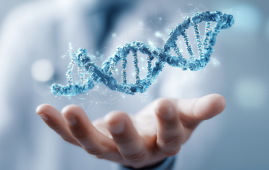

Progressive lung diseases like pulmonary fibrosis cause ripple effects throughout the body. In PF, lung scarring prevents the organs from exchanging gases correctly, resulting in oxygen deficits known as hypoxemia and hypoxia.
Chronic hypoxemia, or low oxygen levels in the blood, affects all parts of the body. We can see some symptoms — like the warmth of our skin tone and digital clubbing — but there are many we can’t. Confusion and other mental symptoms, heart arrhythmias, slow gastrointestinal motility, and fatigue are all related to hypoxia, or low oxygen levels in the tissues.
The magic of a successful lung transplant is that it treats all of the symptoms of hypoxia. Though it may take a while for damaged tissues to recover, adequate oxygenation allows the body to heal.
Of course, the trade-off is accepting a lifetime of immune-suppressing medications to maintain the health of the transplanted organs. While oxygen from healthy lungs promotes healing, the medications can wreak their own havoc on the body. Just like with hypoxia, the side effects of immunosuppressants can be systemic.
Living with transplanted organs is a balancing act, but one that my mom, Holly, is happy to perform. And as a daughter, I am grateful that she chose to pursue it after her IPF diagnosis.
One of the most amazing things I have seen in my life was the rosy color in my mom’s skin the morning after her lung transplant. In the long months leading up to her operation, her pallid complexion was only flushed by coughing fits. New lungs brought life back into her body from the inside out, and the change was immediately evident.
While her new lungs and oxygenated blood gave her skin a healthy glow, her transplant medications increased her risk of developing skin cancer. With a family history of melanoma, we do not take this lightly. For starters, my mom sees a dermatologist every three months to check for skin cancers. Most people only have biannual visits, but individual risk factors can increase the frequency of checkups.
I want to share some other tips that we can all use to protect ourselves from skin cancer.
Use good sunscreen correctly
We are all familiar with sunscreen, but do we use it correctly? Do we use it every day? Do we reapply? I am guilty of being a once-a-day sunscreen user. Unless I feel myself burning, I won’t think to reapply. Unfortunately for bad sunscreen users like me, the sun can damage our skin even if we feel comfortable with the heat of the rays.
Doctors recommend a broad-spectrum (UVA and UVB) sunscreen of at least 30 SPF. Sunscreen works best when it’s applied 15 minutes ahead of going outside, and reapplied every two hours. Also, be sure to check that it is not expired.
It’s important to still use sunscreen on days when you are sitting in the shade or it’s overcast outside. Ultraviolet rays still bounce around, and sunscreen is a great first defense against them. Don’t forget your hands, tops of the feet, and ears!
Wear long-sleeved clothing and sun shirts
All clothing provides some protection from the sun, which you will know if you’ve ever had a farmer’s tan. According to the American Cancer Society, dark fabrics with a tighter weave are the best choice. It isn’t much fun to wear a long-sleeved, black shirt in the summer, but that doesn’t mean you should reach for a tank top if you are on immunosuppressants.
Many companies are making lightweight clothing that has a tighter weave and UV protective coating on the fibers to reduce UV exposure. You can find these types of garments, like sun shirts, by checking the label for a UV protection factor (UPF) rating of 15-50. Higher numbers provide more protection. These fabrics are also more likely to offer sun protection when wet compared with fabrics like cotton.
Wear hats, gloves, and sunglasses
Unsurprisingly, the most common places to get skin cancer are on the face, head, and hands. A hat is a great way to protect the head and face. A wide-brimmed hat even offers protection for your neck and shoulders. Plus, they are definitely in style right now, so get yourself a big hat and pair it with some stylish sunglasses to protect the delicate areas around your eyes.
To complete the look, get some sun gloves! Sun gloves are thin, lightweight, often fingerless gloves that protect your hands. We might not think about our hands getting burnt, but activities like hiking with poles, golf, biking, and fishing leave our hands exposed for long periods.
What do you do to protect yourself from the sun? Have you had skin cancer issues after a lung transplant? Let us know in the comments below.
more recommended stories
 Can Ketogenic Diets Help PCOS? Meta-Analysis Insights
Can Ketogenic Diets Help PCOS? Meta-Analysis InsightsKey Takeaways (Quick Summary) A Clinical.
 Ancient HHV-6 Genomes Confirm Iron Age Viral Integration
Ancient HHV-6 Genomes Confirm Iron Age Viral IntegrationKey Takeaways for HCPs Scientists reconstructed.
 Fat-Regulating Enzyme Offers New Target for Obesity
Fat-Regulating Enzyme Offers New Target for ObesityKey Highlights (Quick Summary) Researchers identified.
 Gestational Diabetes Risk Identified by Blood Metabolites
Gestational Diabetes Risk Identified by Blood MetabolitesKey Takeaways (Quick Summary for Clinicians).
 Pelvic Floor Disorders: Treatable Yet Often Ignored
Pelvic Floor Disorders: Treatable Yet Often IgnoredKey Takeaways (Quick Summary) Pelvic floor.
 Circadian Control of Neutrophils in Myocardial Infarction
Circadian Control of Neutrophils in Myocardial InfarctionKey Takeaways for HCPs Neutrophil activity.
 E-Cigarette Use and Heart Attack Risk in Former Smokers
E-Cigarette Use and Heart Attack Risk in Former SmokersKey Takeaways for Clinicians and Nurses.
 Ultramarathon Physiology: What HCPs Should Know?
Ultramarathon Physiology: What HCPs Should Know?Ultramarathon Metabolism: What Happens to the.
 High-Intensity Training and Oxidative Stress Insights
High-Intensity Training and Oxidative Stress InsightsNew Evidence Linking High-Intensity Training and.
 Sterilized Fermented Beverage for Obesity: New Evidence
Sterilized Fermented Beverage for Obesity: New EvidenceEarly Insights Into a Sterilized Fermented.

Leave a Comment